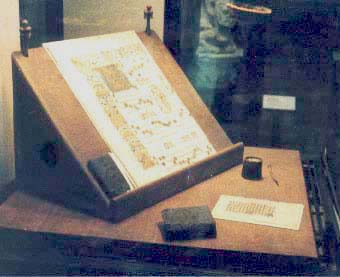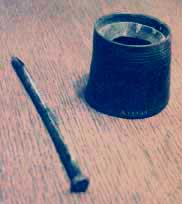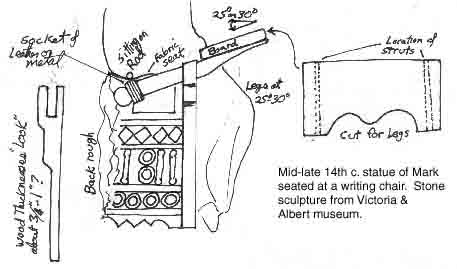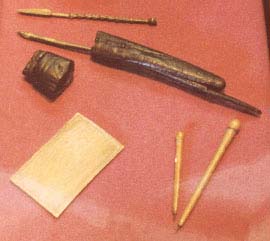
Scribe
Tools Page
of
Randy Asplund
This page will eventually be expanded
with new images
© Randy Asplund
© Randy Asplund
The images below are my photographs from museums. I have a
lot more material than this, but most of my records are on video
because I can make same-time verbal notes and shoot them under
better lighting in the round. These objects are on my tapes, so
if you really have questions, I can look up details like how the
pieces are joined in the calligraphy stand or what the tooling
looks like on the leather pen case. The referances for time and
place are more complete there as well. Please don't ask unless
you seriously want to know since it means digging it out of archive.
However, if you do really want to know, I would be happy to get
for you what I have.
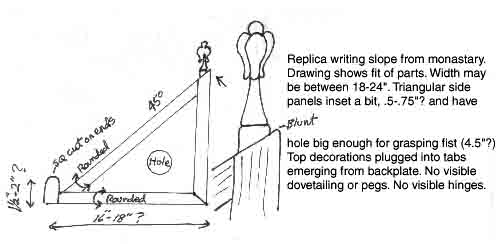 Diagram of the writing slope depicted above left A Writing Chair The Following are requested drawings of how the pieces fit together to make the calligraphy stand and a scribe's chair. These rough sketches were made while reviewing video tape. The camera caught them in the round, but the measurements are guesses. Sorry there is not much to go on, but this should be enough for a person familiar with medieval furniture to reproduce a copy. |
||||
|
||||
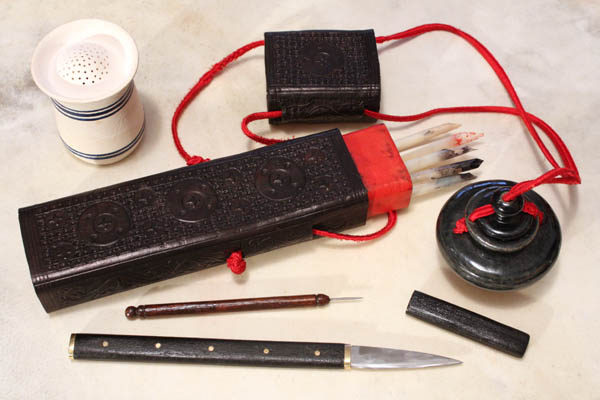 This is my late 15th/early 16th c. writing kit. There is a ceramic pounce pot, a tooled leather case for my pens and knive, a ceramic ink pot, an awl, and a quill knife. I made all of these items and will make more on commission. The case and ink poy are on cords so they may hang over the belt. 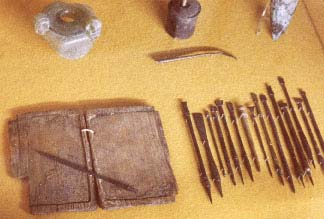 Roman period wax tablet, metal and ivory styluses, and ink wells from the Museum of London. Painter's Brush Trays 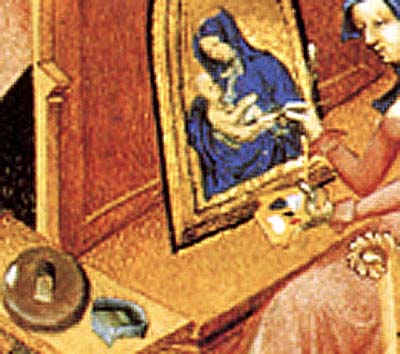
In this image the artist holds a palette with viscous paint. It is
therefore possibly to be an oil based paint. Why would she have a brush
tray beside her? Because it was common to use a brush for each color
and not to clean them in turpentine between as we do today. The brushes
were left in oil.
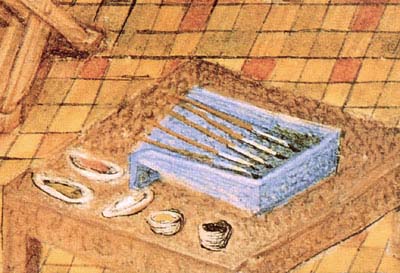 Detail of Thamar painting an anconna. French 1402 copy of Boccaccio's De Claris Mulieribus.
Here we also see brush trays, but in both the illustration above and
the illustration below we see colors kept in shells. There is a
particular mussel shell in Europe with a white interior. We also see a
jar of liquid. I surmise that since this is a panel painting being
created, but the colors are fluid, this may very well represent an
illustration of a painter using yolk tempera medium. The jar would
contain water. Since yolk dries hard in the brush very rapidly, it is
useful to keep the brushes wet while switching back and forth. In this
way the hairs are not stressed by the brittle paint traces that would
otherwise dry on them.
That being said, another illustration, also in Boccaccio's De Claris Mulieribus, shows an artist with a similar palette of viscous paint, no tray, and the extra brushes laying upon a raised bar to keep their hairs off the table. This could imply it is an oil painting. She also has shells filled with fresh colors, but medieval oils were used thinner than we use them. It doesn't necessarily mean it was tempera. 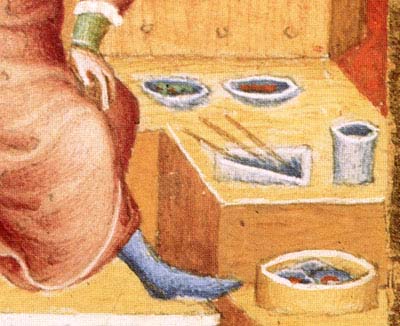 Detail of St. Luke as a painter, c 1360, Bohemia. The Gospel Book of John of Troppau.
But what about illuminators? Did they use brush trays? Why don't we see
images of that?
First of all, the earlier you go, the fewer real tools are represented in images of artists at work. The portraits are usually about the person, not the tools. The renaissance does show more portraits with more tools, but it is seldom a complete workshop laid out exactly as one would use it. There are a few exceptions. Many illuminators also created works in other paint media, so it is reasonable to expect those who did that to have a set of tools for the other media. But did they use these trays for illuminating? We know that the primary and virtually universal medium for panel painting through until the 15th century was egg yolk tempera. They started adding oil at a 1:1 ratio with the yolk to make an emulsion that was water soluble and was also called egg tempera. In our 1360 illustration above, the artist is probably working in just egg yolk tempera. If you have a few brushes at work, and they have paint in them, and the paints are expensive, so you don't want to waste a lot of pigment by swirling the brush clean in you water jar every time you change or put it down for a while, would you just lay a brush down with color in it? Of course not. It would dry with paint in it and become hard and brittle. Sure, you could wash it out (since illuminators used aqueous media), but you would still need to soak it first to soften it before using it again. So why not just keep it wet and avoid the hassel? This holds true for both glair and gum arabic paints. But is it really necessary to have a tray when using gum or glair in illumination? No, its not. At least not any more than when using egg yolk tempera, but clearly, they used it for that. If you swirl the brush in water every time before you lay it down long enough to dry out, it will be clean enough that a brief swirl in water will soften it again. But it is an extra step that takes time. And in the meantime, you are probably building a crust of paint in the "heel" of the brush. That is where the hairs enter the "ferrule" which holds them. If paint clogs this area, it will spread the hairs so that they will no longer return to a point. So actually, a brush tray does have some advantages to the illuminator. It seems to be in use by the panel painter using egg yolk tempera, which behaves a lot like the illuminator's paints. At
first I was surprised not to find the tray with illuminators
because there were quite a few examples of sribes at work. But
with closer observartion I realized that the artists were almost
all writers, not illustrating. They were usually pictures of the
Evangelists or
other authors. I noticed that on the rare occasion that illuminators
were depicted at work, I could not see any water containers at
all. No trays, jugs, or anything other than grinding stone, and
shells or small cups with color in them. As a practicing illuminator
I find it very odd that one would not have water imediately available
for the brush to drip water into the shells of color. One needs
it handy. Therefore my personal supposition is that these
depictions are of typical medieval simplicity, without the need to show
all of
the tools. To depict every tool would be adding unnecessary details
to clutter the composition, and that is not typically medieval.
It would be consistant to only show details which indicate the
scene, and color shells and a brush would be enough for that.
|
